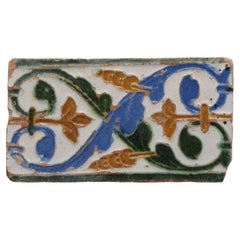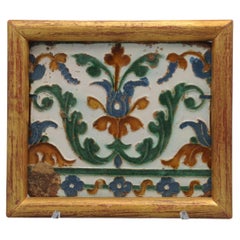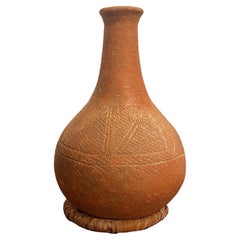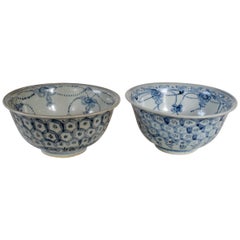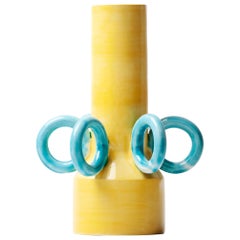16th Century Ceramics
15
to
13
2
15
15
15
530
1,695
7,323
2,502
1,039
4,389
1,112
136
51
255
396
236
946
1,144
512
200
88
15
8
5
1
1
13
8
5
1
1
3
1
Period: 16th Century
Spanish Azulejo Tile Arista y Cuenca - Toledo 16th century
Located in DELFT, NL
Early Arista y cuenca tile made in Toledo. Tile decorated in renaissance with stylized flowers was probably made between 1550 and 1575.
Category
Spanish Renaissance Antique 16th Century Ceramics
Materials
Earthenware
Spanish Azulejo Tile Arista y Cuenca - Toledo 16th century
Located in DELFT, NL
Early Arista y cuenca tile made in Toledo. Tile decorated in renaissance with stylized flowers was probably made between 1550 and 1575.
Category
Spanish Renaissance Antique 16th Century Ceramics
Materials
Earthenware
Spanish Azulejo Tile Arista / Cuenca - Toledo 16th century
Located in DELFT, NL
Early Arista / border tile made in Toledo. Tile decorated in renaissance with stylized flowers was probably made between 1550 and 1575.
Catalogue: La Azulejería Toledana a Través ...
Category
Spanish Renaissance Antique 16th Century Ceramics
Materials
Earthenware
Vase de fouille (Niger, Afrique)
Located in PARIS, FR
Peut-être 15e-17e s. objet de fouille du Niger (Afrique), belle engobe en argile rouge avec bandes incisées, col haut se terminant par une lèvre évasée, bel exemplaire.
Bel objet décoratif...
Category
Nigerien Tribal Antique 16th Century Ceramics
Materials
Terracotta
Pair of Ming Dynasty Bowls with Pattern of Interlocking Hexagons
Located in Atlanta, GA
Pair of Ming Dynasty Bowls with Pattern of Interlocking Hexagons, Wanli period (1572-1620).
This handsome pair of bowls with a slightly fluted rim features an outer pattern of hexago...
Category
Chinese Ming Antique 16th Century Ceramics
Materials
Porcelain
19th Century Spanish Terracotta Tile "Socarrat" of Pork and Tree
Located in Marbella, ES
The socarrat is a slab of fired clay or thick tile, glazed in white and generally decorated in reddish or brownish and blackish tones, intended to be placed between beams, on roofs a...
Category
Spanish Antique 16th Century Ceramics
Materials
Ceramic
19th Century Spanish Terracotta Tile "Socarrat" of an Eagle
Located in Marbella, ES
The socarrat is a slab of fired clay or thick tile, glazed in white and generally decorated in reddish or brownish and blackish tones, intended to be placed between beams, on roofs a...
Category
Spanish Antique 16th Century Ceramics
Materials
Ceramic
19th Century Spanish Terracotta Tile "Socarrat" of Birds and Flowers
Located in Marbella, ES
The socarrat is a slab of fired clay or thick tile, glazed in white and generally decorated in reddish or brownish and blackish tones, intended to be placed between beams, on roofs a...
Category
Spanish Antique 16th Century Ceramics
Materials
Ceramic
19th Century, Spanish Terracotta Tile "Socarrat" of Fleur-de-lis
Located in Marbella, ES
The socarrat is a slab of fired clay or thick tile, glazed in white and generally decorated in reddish or brownish and blackish tones, intended to be placed between beams, on roofs a...
Category
Spanish Antique 16th Century Ceramics
Materials
Ceramic
Italian Renaissance Plate, Patanazzi Workshop Urbino, End of 16th Century
Located in Milano, IT
Acquareccia plate
Patanazzi workshop
Urbino, last quarter of the 16th century
It measures diameter 17.12 in; foot diameter 11.53 in; height 1.88 in (43.5 cm; 29.3 cm; 4.8 cm).
Weight
State of conservation: wear and a few small minimal detachments of enamel, chipping on the raised areas, peeling of enamel at the brim on the back.
This large, shallow basin is equipped with a wide and convex well. It is umbonate with a contoured center. The brim, short and flat, is enclosed in a double rounded and barely raised edge. The basin has a flat base without rims; it has a slightly concave center in correspondence to the well.
The shape takes inspiration from the basins associated with the metal forged amphora pourers that traditionally adorned the credenza. These were used from the Middle Ages to wash hands during banquets. Two or three people washed their hands in the same basin and it was considered an honor to wash one’s hands with an illustrious person.
The decoration is arranged in concentric bands with, in the center of the umbo, an unidentified shield on a blue background: an oval banded in gold with a blue head, a gold star and a field with a burning pitcher.
Rings of faux pods separate the center from a series of grotesque motifs of small birds and masks. These go around the basin and are, in fact, faithfully repeated on the brim. The main decoration develops inside the flounce of the basin, which sees alternating symmetrical figures of winged harpies and chimeras. The ornamentation, outlined in orange, green and blue, stands out against the white enamel background.
This decorative style, defined since the Renaissance as “grottesche” or “raffaellesche”, refers to the decorations introduced after the discovery of the paintings of the Domus Aurea towards the end of the fifteenth century. The discovery of Nero's palace, buried inside Colle Oppio by damnatio memoriae, occurred by chance when a young Roman, in 1480, fell into a large crack which had opened in the ground on the hill, thus finding himself in a cave with walls covered with painted figures.
The great artists present in the papal city, including Pinturicchio, Ghirlandaio, Raffaello, immediately visited these caves. The decorations found there soon became a decorative subject of immense success: the term grotesque , with the meaning of “unusual,” “caricatured,” or “monstrous,” was later commented by Vasari in 1550 as “una spezie di pittura licenziose e ridicole molto”( “a very licentious and ridiculous kind of painting”).
The decorations “a grottesche” also widely circulated in ceramic factories, through the use of engravings, variously interpreted according to the creativity of the artists or the requests of the client.
Our basin is reflected in similar artifacts produced at the end of the sixteenth century by the factories of the Urbino district. See the series of basins preserved in the main French museums, among which the closest in morphology is that of the Campana collection of the Louvre (Inv. OA1496); this however has a more complex figure decoration, while the decoration of our specimen is sober and with a watercolor style.
The style, sure in its execution, approaches decorative results still close to the works produced around the middle of the sixteenth century by the Fontana workshop. The decoration is closely linked to their taste, which later finds its natural outlet, through the work of Antonio, also in the Patanazzi workshop. Studies show the contiguity between the two workshops due to the kinship and collaboration between the masters Orazio Fontana and Antonio Patanazzi, both trained in the workshop of Guido Fontana il Durantino. It is therefore almost natural that their works, often created according to similar typologies and under the aegis of the same commissions, are not always easily distinguishable, so much so that the presence of historiated or “grottesche” works by Orazio is documented and preserved in Antonio Patanazzi's workshop. Given that the studies have always emphasized the collaboration between several hands in the context of the shops, it is known that the most ancient “grottesche” works thus far known, can be dated from 1560, when the Fontana shop created the so-called Servizio Spagnolo (Spanish Service) and how, from that moment on, this ornamentation became one of the most requested by high-ranking clients. We remember the works created for the Granduchi di Toscana, when Flaminio Fontana along with his uncle Orazio supplied ceramics to Florence, and, later, other commissions of considerable importance: those for the service of the Duchi d’Este or for the Messina Farmacia of Roccavaldina, associated with the Patanazzi workshop when, now after 1580, Antonio Patanazzi began to sign his own work.
Thus, in our basin, the presence of masks hanging from garlands, a theme of more ancient memory, is associated in the work with more advanced stylistic motifs, such as the hatching of the chimeras and harpies. These are found here on the front with the wings painted in two ornate ways. In addition, the theme of the birds on the edge completes the decoration along the thin brim and can be seen as representing an early style typical of the Urbino district during a period of activity and collaboration between the two workshops. Later, a more “doll-like” decorative choice, typical of the end of the century and the beginning of the seventeenth century, characterized the period of the Patanazzi workshop under the direction of Francesco.
Bibliography:
Philippe Morel, Il funzionamento simbolico e la critica delle grottesche nella seconda metà del Cinquecento, in: Marcello Fagiolo, (a cura di), Roma e...
Category
Italian Renaissance Antique 16th Century Ceramics
Materials
Maiolica
Small Maiolica Plate, Urbino District, 1533-1555
Located in Milano, IT
Maiolica plate (tondino)
Urbino district, Casteldurante or Pesaro, 1533-1555
It measures: diam. 7.48 in (19 cm), foot diam. 2.75 in (7 cm), height 1.0...
Category
Italian Renaissance Antique 16th Century Ceramics
Materials
Maiolica
16th Century Castelli Italian Maiolica Farnese alla turchina Dish
By Castelli
Located in Fort Lauderdale, FL
An extraordinary azure maiolica dish in the Farnese service, made by Castelli d'Abuzzo between 1580 and 1589.
In the peak of the High Renaissance, Cardinal Alessandro Farnese commissioned a dinner service from the Castelli maiolica...
Category
Italian Renaissance Antique 16th Century Ceramics
Materials
Maiolica
A Deruta Maiolica Dish Early 16th Century
Located in Firenze, IT
SHIPPING POLICY:
No additional costs will be added to this order.
Shipping costs will be totally covered by the seller (customs duties included).
The centre painted with archaic de...
Category
Italian Renaissance Antique 16th Century Ceramics
Materials
Maiolica
16th Century Spanish Valencian Manises Lusterware Ceramic Plate
Located in Marbella, ES
16th century Spanish Valencian Manises lusterware plate combining ceramics with metallic glaze.
It has been repaired with iron grapples.
Category
Spanish Antique 16th Century Ceramics
Materials
Iron
Ancient Italian Renaissance Maiolica Crespina, Faenza, 1580 Circa
Located in Milano, IT
Crespina
Faenza, last quarter of the 16th century
Maiolica painted in two colors, light blue and yellow, on a thick, rich layer of white enamel.
It measures 2.24 in (5.7 cm) in height, 6.10 in (15.5 cm) in diameter.
lb 0.55 (kg 0.25)
State of conservation: mimetic restoration.
The small cup has a raised central “umbone”, a perforated brim and a shaped rim. It rests on a high jutting foot. The "crespina" shape, in some inventories is cited as "tacce de frute" (fruit cups). It was particularly appreciated in the Renaissance and has variants based on the formal types and the different sizes. The decoration, made according to the dictates of the “compendiario” style, used few standardized colors: blue and yellow on a thick white and shiny enamel, deliberately chosen as the colour which was most reminiscent of silver. This choice derived from a trend in creative design of the era: the shapes used in the molds were often taken from metal objects. An idea which would last throughout the Renaissance.
The work shows, in the middle of the “umbone”, a winged putto stepping forward while playing a long thin trumpet.
The depiction of the putto is fully representative of the repertoire of the Faenza workshops of the sixteenth century.
Some specimens with this type of decoration have been published in a volume by Carmen Ravanelli Guidotti: there appears the whole productive repertoire of this fundamental moment of transition between the taste for the “istoriato” style and the great simplification of decoration in the “compendiario” period. This style, in its simplicity, however, saw its expression in a rather varied collection of decorative subjects, including old-fashioned busts...
Category
Italian Renaissance Antique 16th Century Ceramics
Materials
Maiolica
Related Items
Olio Ceramic Vase by Arianna De Luca
Located in Geneve, CH
Olio vase by Arianna De Luca
Dimensions: height 23 x diameter 16 cm
Materials: Ceramic
Olio vase is part of the Folcloristica series. A collection inspired by the mood and lifesty...
Category
Italian Modern 16th Century Ceramics
Materials
Ceramic
Rare Emaux de Longwy Ceramic Boule Vase by Garouste and Bonetti Limited 1 of 5
Located in Miami, FL
This Boule vase “Ornament “ is a rare limited edition numbered 1/5 by Elizabeth Garouste was born in 1949 in Paris and Mattia Bonetti in 1952 in Lugano (Switzerland). They pooled their work from 1980 to dedicate themselves to the creation of pieces of furniture and interior decoration. They start with the decoration of the Palace that Fabrice Eamer asks them to design. Then shortly after, the Néotu Gallery publishes them. Their furniture, baroque and barbarian, surprises, made up of heterogeneous and unusual materials, such as rock, hammered bronze, raffia, leather, skin, logs and glass ... They are at the instigation of fashion "barbaric". For their work, they use references such as the Middle Ages, Africa, through the poetry of Cocteau, the Venetian baroque and neoclassicism. They have also been edited by the “Waiting for the Barbarians” galleries, David Gill, Kréo, Lou Fagotin...
Category
French Modern 16th Century Ceramics
Materials
Ceramic
2 Chinese Blue and White Porcelain Bowls from the Ship Wrecked "Tek Sing"
Located in Palm Beach, FL
In 1822 the Chinese Junk "Tek Sing" or true star sank in the south
China sea, where the ship and its cargo remained until salvaged in
1999. These antique blue...
Category
Chinese Chinese Export Antique 16th Century Ceramics
Materials
Porcelain
Ramina Ceramic Vase by Arianna De Luca
Located in Geneve, CH
Ramina vase by Arianna De Luca
Dimensions: height 20 x diameter 20 cm
Materials: ceramic
Ramina is part of the Folcloristica series. A collection inspired by the mood and lifestyl...
Category
Italian Modern 16th Century Ceramics
Materials
Ceramic
Qing Dynasty Chinese Blue & White Porcelain / Ceramic Plate, c. 1850
Located in Jimbaran, Bali
This Chinese ceramic plate is dominated by a blue-grey glaze and features wonderful hand painted blue strokes. Once used as an every day plate it is now a great example of Chinese ce...
Category
Chinese Qing Antique 16th Century Ceramics
Materials
Ceramic, Paint
Qing Dynasty Chinese Blue & White Porcelain / Ceramic Plate, c. 1850
Located in Jimbaran, Bali
This Chinese ceramic plate is dominated by a blue-grey glaze and features wonderful hand painted blue strokes. Once used as an every day plate it...
Category
Chinese Qing Antique 16th Century Ceramics
Materials
Ceramic, Paint
Qing Dynasty Chinese Blue & White Porcelain with Wonderful Strokes, c.1850
Located in Jimbaran, Bali
From the Qing Dynasty, this Chinese ceramic plate is dominated by a blue-grey glaze and features wonderful hand painted blue strokes. Once used as an every day plate it is now a grea...
Category
Chinese Qing Antique 16th Century Ceramics
Materials
Ceramic
Antique Blue & White Fitzhugh Pattern Chinese Export Porcelain Plate
Located in Philadelphia, PA
A fine antique Chinese Export porcelain plate in the Fitzhugh pattern.
Decorated in underglaze blue with floral devices to the face, and a border to the rim with a repeating diamo...
Category
Chinese Chinese Export Antique 16th Century Ceramics
Materials
Porcelain
Set of Six Antique 19th Century Hand Painted Minton Earthenware Ceramic Tiles
By Minton
Located in Hamilton, Ontario
A set of six (one bonus tile thrown in of a double but in bad condition) Victorian hand painted Minton China Works in Stoke-upon-Trent, England, English tiles designed by John Moyr Smith...
Category
English Victorian Antique 16th Century Ceramics
Materials
Ceramic, Earthenware
H 0.38 in W 6 in D 6 in
4 Old or Antique Signed Kakufuku Japanese Kaikemon Imari Porcelain Rice Bowls
By Sakaida Kakiemon Xii
Located in Philadelphia, PA
A fine set of 4 Japanese Imari porcelain bowls
Each decorated throughout with kaikemon blue, red, and green natural scenes and extensive gilding.
Marked to the base with a blue underglaze maker's mark for Kakufuku.
Simply a fine set of Japanese rice bowls...
Category
Japanese Meiji 16th Century Ceramics
Materials
Porcelain
Chinese Kraak period Plate or Dish Porcelain Blue and White, Ming Wanli, Ca 1610
Located in Lincoln, Lincolnshire
This is a hand-painted Chinese Export Kraak porcelain blue and white Side Plate or Dish, which we date to the Ming, Wanli period,( 1573-1620 ), dating to the early 17th Century.
T...
Category
Chinese Chinese Export Antique 16th Century Ceramics
Materials
Porcelain
H 1.11 in Dm 6.23 in
Pair of 18th Century Chinese & Meissen Famille Verte Porcelain Plates
Located in Fort Lauderdale, FL
A pair of famille verte porcelain plates, the left made in China during the Kangxi period (r. 1662–1722) and the right a copy by Meissen made circa 1740.
Chinese porcelain has alw...
Category
Chinese Chinese Export Antique 16th Century Ceramics
Materials
Porcelain
Previously Available Items
Spanish Azulejo Tile Arista y Cuenca - Toledo 16th century
Located in DELFT, NL
Early Arista y cuenca tile made in Toledo. Tile decorated in renaissance with stylized flowers, probably made between 1550 and 1575.
Category
Spanish Renaissance Antique 16th Century Ceramics
Materials
Earthenware
16th Century Exceptional Large Biot Oil Vessel Jar - ex. Biot Museum
By Biot
Located in Doylestown, PA
Exceptional, large 16th century Biot oil vessel jar, exhibited for years in the museum of Biot, has stamps of the end of the 16th C. The jar and its mar...
Category
Antique 16th Century Ceramics
Materials
Ceramic
16th Century Polychrome Octagonal Cup
Located in Atlanta, GA
16th Century Polychrome octagonal cup, Ming dynasty. Endearing decor of little children, painted in red and green on a cream-colored background. The cup is partially molded, with the...
Category
Chinese Antique 16th Century Ceramics
Materials
Porcelain
Rare Magenta Color Shipwreck Animist Vessel, Vietnam, 16th Century
Located in New York, NY
16th century Vietnam animist vessel from the Turiang shipwreck discovered in 1998 in the South China Sea.
Rare magenta accent color.
Natural marine growth from being submerged for ...
Category
Vietnamese Antique 16th Century Ceramics
Materials
Terracotta
Sawankhalok Ship Wreck Vessel, Thailand, 16th Century
Located in New York, NY
16th century Thailand Sawankhalok vessel from the Turiang shipwreck discovered in 1998 in the South China Sea.
Natural marine growth from being submerged for over 300 years.
From a...
Category
Thai Antique 16th Century Ceramics
Materials
Ceramic
16th Century Sawankhalok Ship Wreck Vessel, Thailand
Located in New York, NY
16th century Thailand Sawankhalok vessel from the Turiang shipwreck discovered in 1998 in the South China Sea.
Natural marine growth from being submerged for over 300 years.
From a...
Category
Thai Antique 16th Century Ceramics
Materials
Ceramic
16th Century Sawankhalok Ship Wreck Vessel, Thailand
Located in New York, NY
16th century Thailand Sawankhalok vessel from the Turiang shipwreck discovered in 1998 in the South China Sea.
Natural marine growth from being submerged for over 300 years.
From a...
Category
Thai Antique 16th Century Ceramics
Materials
Ceramic
16th Century Sawankhalok Ship Wreck Vessel, Thailand
Located in New York, NY
16th century Thailand Sawankhalok vessel from the Turiang shipwreck discovered in 1998 in the South China Sea.
Natural marine growth from being submerged for over 300 years.
From a...
Category
Thai Antique 16th Century Ceramics
Materials
Ceramic
Ancient Maiolia Drag Jar or Albarello, Montelupo, 1490-1510
Located in Milano, IT
Tin-glazed earthenware drag jar (albarello)
Montelupo, 1490-1510
It measures: mouth diameter 3.54 in (9 cm), foot diameter 3.46 in (8.8 cm), height 7.48 in (19 cm)
Weight: 1.34 lb (612 g)
State of conservation: intact, signs of use on the rim and slight chips on the raised areas. Kiln-support marks.
The small apothecary container for unguents has a cylindrical body which tapers towards the base and the flat foot. The shoulder is narrow and high, with elegant lines. The mouth is wide with a rounded edge and turned-out lip.
The vase has an enameled interior. The exterior shows a white enamel surface entirely covered with "palmetta persiana" motifs (pinecone motifs). These are arranged symmetrically and horizontally. A series of double sinuous lines encircle an area where, along with the main decoration, there are "alla porcellana" (porcelain) motifs combined with green and orange oval leaves. A "nastro spezzato" (broken ribbon) decoration, usually found on the brim of plates, runs along the neck to complete the decoration.
All the ornaments attest to an oriental inspiration that can be traced back relatively accurately to the Iranian or Syrian area. This decoration was also very successful in other contemporary Italian manufacturers (C. Ravanelli Guidotti, Thesaurus di opere della tradizione di Faenza, Faenza 1998, pp. 169-174), but in Montelupo it was interpreted in various ways due to the eclectic nature of its painters.
There is an abundant use of the precious cobalt blue, almost in relief, and is often associated with yellow-orange inserts. This imitates the metallic luster in symmetrical points between the petals.
The background is decorated with thin sinuous lines, which, for Fausto Berti (Berti F., Il Museo della ceramica di Montelupo, Firenze 2008, pp. 270-272, n. 22 g e Berti F., Storia della ceramica di Montelupo, Montelupo Fiorentino 1999, p. 140), might suggest the presence of a stem that supports the corollas and two-colored leaves. These, pointed and accompanied by dots, spirals and subtle "alla porcellana" (porcelain) motifs, fill the white background.
The form and the decorative synthesis described above lead us to an even earlier dating, between the end of the fifteenth century and the first twenty years of the sixteenth century, when the palette chosen by the workshops was still rich and marked and the pictorial ductus was sought after. (Berti F., Storia della ceramica di Montelupo. Montelupo Fiorentino, 1999, p. 138-140).
The documentation of this decoration is more common in open forms than in closed ones. For this reason, our albarello finds rare examples of comparison, three of which are very close: an albarello, similar in size, is kept at the Museé du Louvre in Paris (Giacomotti. J., Catalogue des majoliques des musées nationaux, Parigi 1974, p. 39 cat. 143); another one is at the Victoria & Albert Museum in London (Sani E. P., Italian Renaissance Maiolica...
Category
Italian Renaissance Antique 16th Century Ceramics
Materials
Earthenware
Rare Dutch Majolica Plate with Star Design, Second Half 16th Century
Located in AMSTERDAM, NH
A rare Dutch Majolica plate with a star design.
Northern Netherlands, probably made in the city of Haarlem.
Made 1560 - 1580
Dutch majolica is one ...
Category
Dutch Renaissance Antique 16th Century Ceramics
Materials
Ceramic, Majolica
Free Shipping
H 1.58 in Dm 9.26 in
Blue and White Kraak Porcelain Charger Ming Dynasty, Wanli Period
Located in London, GB
A fine blue and white kraak porcelain charger, The central cartouche with scalloped edge containing a scene of a bird surrounded by flowers and leafs, ...
Category
Chinese Antique 16th Century Ceramics
Materials
Porcelain
15th-16th Century Vietnamese Antique Bowl/ Southeast Asian Beautiful Pottery
Located in Sammu-shi, Chiba
This bowl was made in Vietnam around the 15th-16th century.
In Japan, trade with Vietnam was active from the Muromachi period (around the 15th-16th centuries).
Many Vietnamese tea ...
Category
Vietnamese Other Antique 16th Century Ceramics
Materials
Pottery
Recently Viewed
View AllMore Ways To Browse
Masons Ironstone Imari Plate
Ceramic Candy Dish
Wedgwood Green Leaf Plate
Antique Glass Swan Dish
Faux Bois Ceramic Vallauris
Wedgwood China Ware
Ceramic Tankard
Morten Lobner Espersen
Jean Cocteau Dish
Morten Lobner
Kettle Pottery
Lisa Larson Cat
Josef Hoffman Silver
Nanking Blue China
Stig Lindberg Horse
Talavera Plate
Ceramic Beer Stein
Barbotine Fruit
